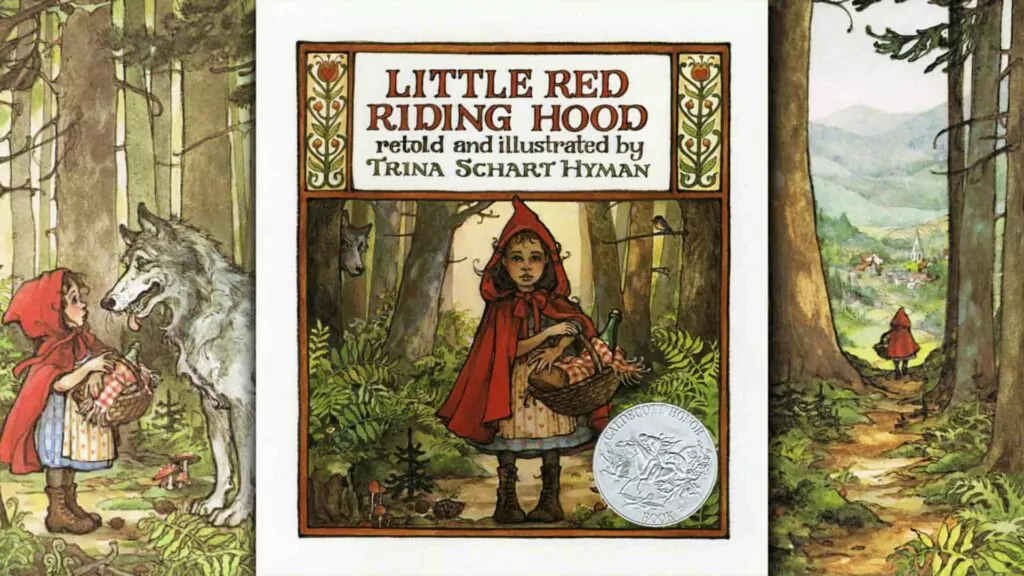retold by Margaret Hodges
illustrated by Trina Schart Hyman
1990 / 32 pages
There are a lot of “powder-puff” stories for the pre-K set – stories where everyone is nice, they do nice things, and a nice time is had by all.I’m all for niceness, but there is a certain lack of drama to these stories. And after reading one after another of them to my three-year-old I noticed she was having a hard time dealing with stories that included disagreements, disappointment, or suspense. Anything that wasn’t the nicest of nice was becoming scary to her.
Steps needed to be taken to rectify this situation, and what better approach than to tell her stories of valor, self-sacrifice, and dragons!
Admittedly, the first go-around wasn’t a success. With no dragon books at hand I made up a story about daddy fighting a dragon in defense of my daughters, and then getting eaten by the fierce beast! Now, I knew this dramatic turn would push my little one’s limits, but I was going to quickly follow it with my climactic reemergence, sword in hand, out of the belly of the now-dead dragon. A fantastic ending, if I do say so myself. But, alas, my daughter wasn’t around to hear it…she had already fled the room.
For my second go, I decided to turn to the experts and get an actual book, one of the very best dragon-fighting stories ever crafted: Saint George and the Dragon. In this account, taken from Edmund Spenser’s classic Faerie Queene, the brave Red Knight is asked by Princess Una to come save her land from a dreadful dragon. And come he does, along with his dwarf companion.
The battle that then commences is beyond epic. The fearsome dragon has “scales of brass fitted so closely that no sword or spear could pierce them,” leaving the Red Knight no opportunity to slice into him. It is only “the strength of the blow” that gives the dragon pause. The first day’s battle ends when the Red Knight’s thrust glances off the dragon’s neck, but pierces its left wing. In fury, the beast throws the knight and his horse to the ground and then bellows
“…the like was never heard before – and from his body, like a wide devouring oven, sent a flame of fire that scorched the knight’s face and heated his armor red-hot.”
The knight falls, and the dragon thinks he has won.
But that was just Round 1! The spot where the knight fell, it so happens, was an ancient spring which cools his armor and restores his strength. So much so that the next morning he was ready to do battle again. Two more rounds follow, with the dragon losing a paw, and a length of tail before ultimately succumbing to the Red Knight in Round 3.
So why should little kids be exposed to drama? Because stories, in addition to being a source of entertainment, can also serve as a means of education. We don’t live in a powderpuff world – there are dragons that need slaying. What’s more, Christians need to teach their children that the fiercest dragons out there can be and must be slain. God calls us to battle, so while stories about tea parties and talking puppies have their place, at some point training must commence. We have to be properly prepared for disagreements, disappointments, drama and dragons.
I learned something from my little girl when I saw how she could make it through the scary parts so long as she was assured it would all end well. Lots of scary stuff in life too, but what do we ha ve to fear, knowing as we do that God has already won?
ve to fear, knowing as we do that God has already won?
So, to sum up, this is an epic tale, retold in the very best way imaginable – my English teaching brother assures me no one has done a better job than author Margaret Hodges. The illustrations are detailed, and while not gore-free (we do see blood spurting from the dragon’s tail when it gets cut off) certainly not gory. Both children and adults will enjoy time just pondering the pictures – when people talk of visual feasts, this is what they mean.
The only caution I can add is a bit comical – there is some small elfish immodesty in these pages, with the clearest example in the last picture here on the right. The elves are not part of the story (they are a part of the larger Edmund Spenser tale Faerie Queen, of which this is an extracted part) but appear on the title page, and in small pictures that frame each page’s big center image. The elves, in one or two instances, are entirely naked, but the pictures are so small as to be easy to miss, and the elves themselves so childlike as to be quite innocent-looking. Nothing lascivious here and I mention it only so that those who might find such pictures objectionable aren’t surprised by them.
Children from 3 or 4 to as old as 8 or 9 will love this story. And their dads will enjoy reading it to them.












